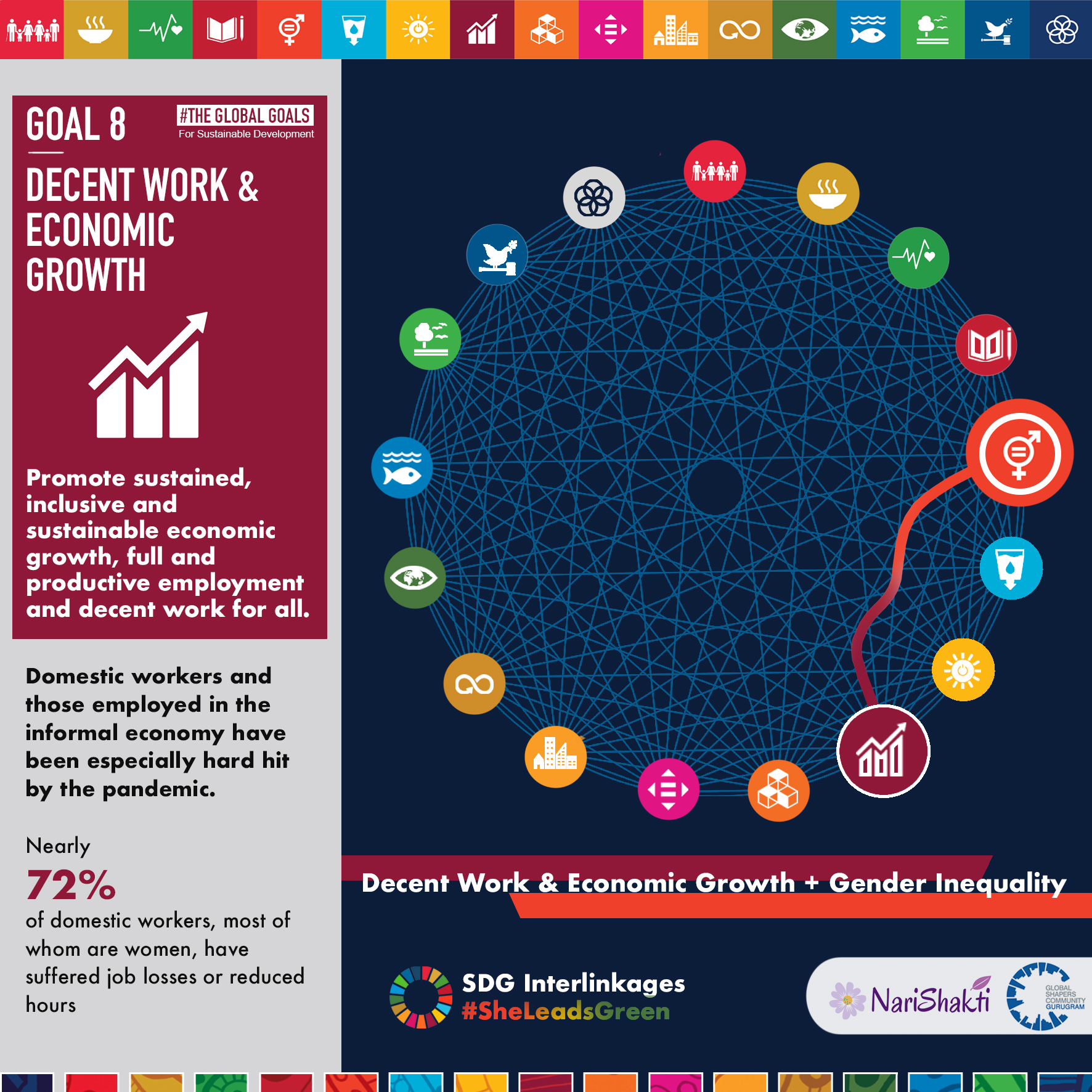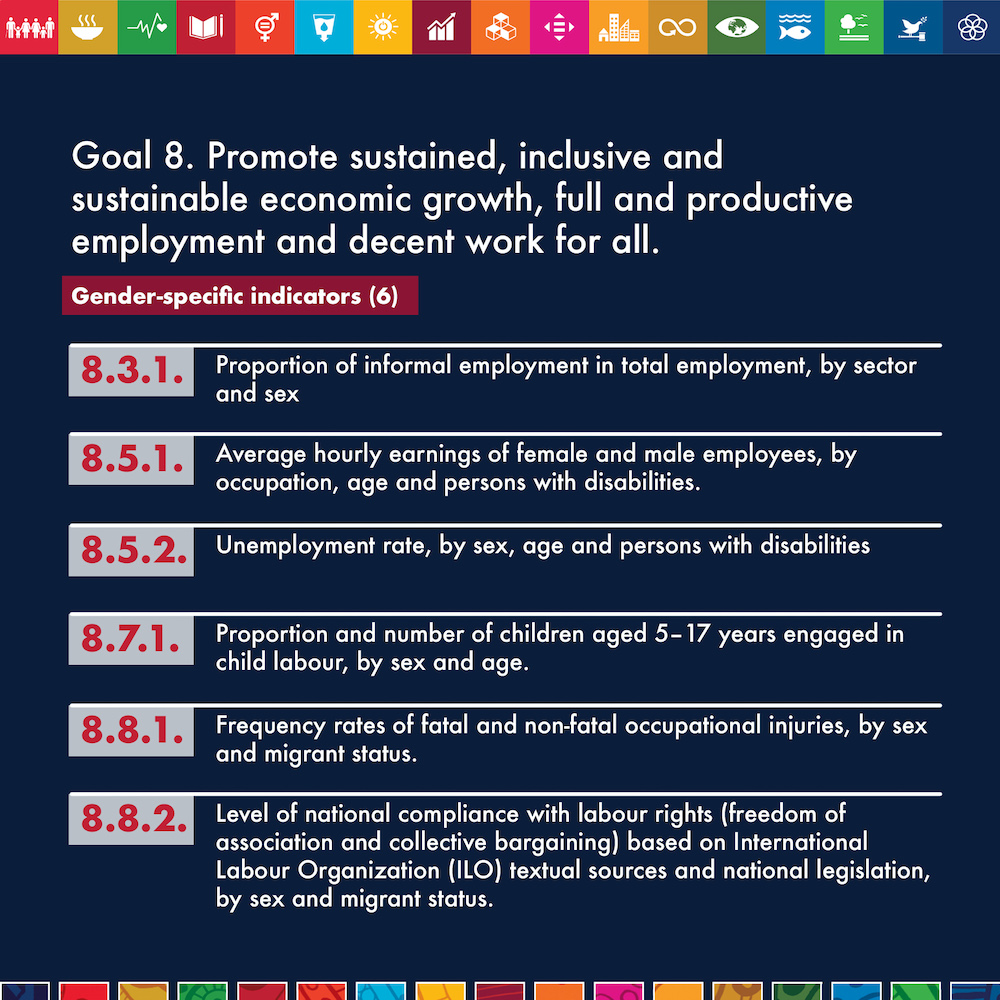
Gender parity for decent work and economic growth (SDG 8)

Why do we need to look at decent work and economic growth from a gender lens?
- The inequalities which persist with respect to sustainable and inclusive economic growth and provision of decent work and employment for all, make it integral that SDG 8, on Decent Work and Economic Growth is seen through a gender lens. There is empirical evidence which suggests that the labor force participation of women aged 25-54 is 55%, as compared to 94%b for men at the same age, In fact, within the 17 indicators for SDG 8, 6 of the indicators are gender-specific. While in 2018, young women were twice as likely to be unemployed as compared to men. there were also twice as likely to be outside the labor force, or outside school or not in a training program.
- These inequalities have been further exacerbated by the pandemic, where women faced the brunt of the unemployment which followed the lockdown, especially in the informal sector and unpaid care, where women face a disproportionate burden, as per McKinsey.
- As per calculations by McKinsey, though women make up 39% of global employment, they suffered 54% of job losses as a result of the pandemic. Therefore, in the context of a recovery from the pandemic increasing existing inequalities, it is integral that decent work and economic growth is looked at from a gender lens.
How is decent work and economic growth and gender-linked?
There are 12 targets and 16 indicators to achieve SDG 8. Out of 16 indicators, 6 are gender-specific.

Decent Work and Economic Growth, which is SDG 8, is linked to gender due to two targets of SDG 8 directly linked with gender (target 8.5 on equal pay and target 8.8 on safe working environments, especially for women migrants). There are also existing examples that clearly show the interlinkage of gender with decent work and economic growth.
- Under various programs by Barefoot College International, women are trained to practise sustainable livelihoods like beekeeping and coffee harvesting. These women also receive commissions for selling Solar products to the rural clientele. These initiatives have led to sales of more than INR 50,00,000 for women.
- The MUDRA loan scheme by the Indian government had over 60% of beneficiaries being women, pointing towards a willingness of women towards entrepreneurship and financial independence, which is what decent work and economic growth also tries to promote to bridge inequalities
What outcomes can we achieve in SDG 8 if we reach gender parity?
- According to a study by McKinsey, in a scenario in which women play an identical role in labor markets to men globally, as much as $28 trillion, or 26%, could be added to global annual GDP by 2025 itself.
- This is more than enough to bridge the climate finance gap needed to fund the battle against climate change, which stands at €810 billion ($894 billion) by 2030.
- Therefore, just increasing the participation of women in the labor force will increase the world’s GDP sufficiently enough for financing sustainable development and effective climate change mitigation.
- Gender parity when it comes to the provision of decent work and economic growth is critical, given, not only the gender-specific indicators in SDG 8 but also in the overall promotion of inclusive and sustainable economic growth and providing decent work and employment for all.
References
- https://www.weforum.org/agenda/2019/09/why-women-cannot-be-spectators-in-the-climate-change-battle/
- https://www.barefootcollege.org/aspirational-districts-an-update-on-our-current-work/
- https://www.mckinsey.com/featured-insights/future-of-work/covid-19-and-gender-equality-countering-the-regressive-effects
- https://www.unwomen.org/en/news/in-focus/women-and-the-sdgs/sdg-8-decent-work-economic-growth
- https://www.unwomen.org/-/media/headquarters/attachments/sections/library/publications/2019/progress-on-the-sdgs-the-gender-snapshot-2019-single-pages-en.pdf?la=en&vs=5813


